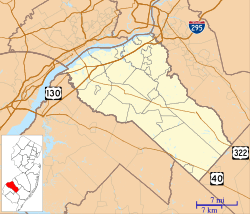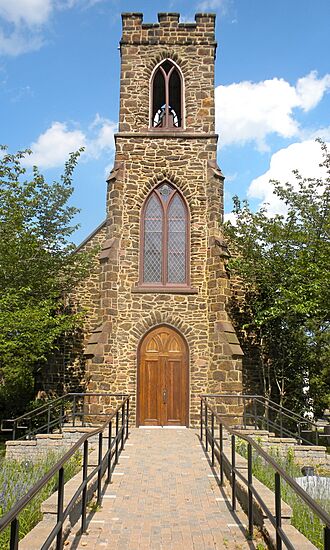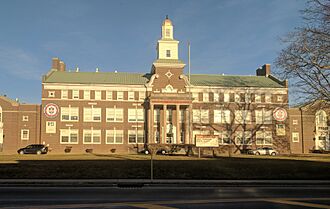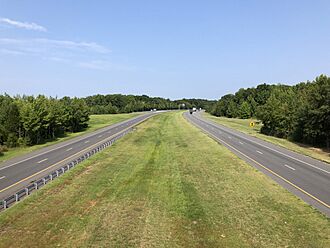Glassboro, New Jersey facts for kids
Quick facts for kids
Glassboro, New Jersey
|
||
|---|---|---|
|
Borough
|
||
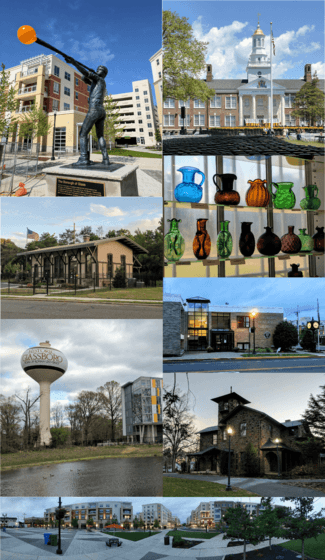
Clockwise from top left: Glassblower statue, Bunce Hall at Rowan University, glass bottles from area glassworks, Glassboro Municipal Building, Whitney Mansion, panorama of the Rowan Boulevard downtown area, Glassboro Water Tower, and Historic West Jersey Depot (old train station)
|
||
|
||
| Nickname(s):
Summit City; Borough of Glass
|
||
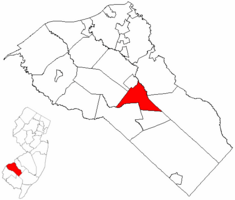
Location of Glassboro in Gloucester County highlighted in red (right). Inset map: Location of Gloucester County in New Jersey highlighted in red (left).
|
||

Census Bureau map of Glassboro, New Jersey
|
||
| Country | ||
| State | ||
| County | ||
| Established | 1779 | |
| Incorporated | March 11, 1878 | |
| Named for | Glass industry | |
| Government | ||
| • Type | Borough | |
| • Body | Borough Council | |
| Area | ||
| • Total | 9.36 sq mi (24.24 km2) | |
| • Land | 9.32 sq mi (24.14 km2) | |
| • Water | 0.04 sq mi (0.10 km2) 0.41% | |
| Area rank | 213th of 565 in state 14th of 24 in county |
|
| Elevation | 148 ft (45 m) | |
| Population
(2020)
|
||
| • Total | 23,149 | |
| • Estimate
(2023)
|
23,987 | |
| • Rank | 115th of 565 in state 4th of 24 in county |
|
| • Density | 2,483.8/sq mi (959.0/km2) | |
| • Density rank | 254th of 565 in state 8th of 24 in county |
|
| Time zone | UTC−05:00 (Eastern (EST)) | |
| • Summer (DST) | UTC−04:00 (Eastern (EDT)) | |
| ZIP Code |
08028
|
|
| Area code(s) | +1 (856) exchanges: 442, 863, 881, 256 (Rowan University) | |
| FIPS code | 3401526340 | |
| GNIS feature ID | 0885231 | |
Glassboro is a town, also called a borough, in Gloucester County, New Jersey. It's part of the larger Philadelphia metropolitan area. In 2020, Glassboro had 23,149 people living there. This was the highest number ever counted for the town.
A big reason for Glassboro's growth is Rowan University. This university was started in 1923 and used to be called Glassboro State College. Glassboro is located in a region known as South Jersey. The town was named after its important glass industry.
Contents
Glassboro's Story: A Look Back in Time
Glassboro's history began with making glass. In 1779, Solomon Stanger founded the town, calling it Glass Works in the Woods. Many glass companies have operated here over the years. Some famous ones include Whitney Brothers Glass Works and Anchor Hocking.
Rowan University and the Glassboro Summit
Rowan University was founded in 1923. It was first known as Glassboro Normal School. Later, it became Glassboro State College.
A very important event happened at the university in 1967. It was called the Glassboro Summit Conference. U.S. President Lyndon B. Johnson and Soviet Premier Alexei Kosygin met there. They talked for three days, from June 23 to June 25.
The meeting place was chosen because it was halfway between New York City and Washington, D.C.. Kosygin wanted to meet in New York, and Johnson preferred Washington. The friendly feeling of their meeting was called the "Spirit of Glassboro." Even though they didn't agree on everything, it was a big step for peace talks.
President Reagan's Visit
In 1986, President Ronald Reagan made history in Glassboro. He was the first sitting president to speak at a high school graduation. He gave a speech at Glassboro High School's ceremony.
Where is Glassboro?
Glassboro covers about 9.36 square miles (24.24 square kilometers). Most of this area is land.
Glassboro shares its borders with several other towns in Gloucester County. These include Clayton, Elk Township, and Monroe Township.
Glassboro's Weather
Glassboro has hot and humid summers. Its winters are usually mild to cool. This type of weather is known as a humid subtropical climate.
How Many People Live in Glassboro?
| Historical population | |||
|---|---|---|---|
| Census | Pop. | %± | |
| 1880 | 2,088 | — | |
| 1890 | 2,642 | 26.5% | |
| 1900 | 2,677 | * | 1.3% |
| 1910 | 2,821 | * | 5.4% |
| 1920 | 3,073 | 8.9% | |
| 1930 | 4,799 | 56.2% | |
| 1940 | 4,925 | 2.6% | |
| 1950 | 5,867 | 19.1% | |
| 1960 | 10,253 | 74.8% | |
| 1970 | 12,938 | 26.2% | |
| 1980 | 14,574 | 12.6% | |
| 1990 | 15,614 | 7.1% | |
| 2000 | 19,068 | 22.1% | |
| 2010 | 18,579 | −2.6% | |
| 2020 | 23,149 | 24.6% | |
| 2023 (est.) | 23,987 | 29.1% | |
| Population sources: 1880–2000 1880–1920 1880–1890 1890–1910 1910–1930 1940–2000 2000 2010 2020 * = Lost territory in previous decade. |
|||
In 2010, Glassboro had 18,579 people. By 2020, the population grew to 23,149. This shows a big increase, partly because of Rowan University's growth.
Fun and Outdoors in Glassboro
The Glassboro Wildlife Management Area is a large natural space. It covers almost 2,400 acres. This area is great for enjoying nature and wildlife.
Schools and Learning in Glassboro
Glassboro has its own public school system. It serves students from pre-kindergarten all the way through twelfth grade. In the 2022-2023 school year, about 1,895 students attended Glassboro schools.
The schools include:
- J. Harvey Rodgers School (PreK and kindergarten)
- Dorothy L. Bullock School (grades 1-5)
- Thomas E. Bowe Elementary School (grades 6-8)
- Glassboro High School (grades 9-12)
Students in Gloucester County can also apply to the Gloucester County Institute of Technology. This high school offers special technical and job-focused education.
Higher Education: Rowan University
Rowan University is a public university in Glassboro. In 2018-2019, it had about 19,500 students. The university started in 1923 as Glassboro Normal School.
Over the years, Rowan University has grown a lot. It now offers many different study programs. These include business, communications, and engineering.
Rowan Boulevard is a special area downtown. It mixes university life with shops and restaurants. This helps the university grow and makes Glassboro a lively place.
Getting Around Glassboro
Glassboro has many roads for cars. Major roads like Route 47 and Route 55 run north and south. U.S. Route 322 goes east and west.
Buses and Trains
NJ Transit provides bus service. You can take a bus from Glassboro to Philadelphia.
Glassboro used to have passenger train service. The old Glassboro station is being fixed up to be a visitor center. There are plans for a new train line called the Glassboro–Camden Line. This light rail system would connect Glassboro to Camden.
Walking and Biking
Walking is popular, especially around the university. Many students walk because they don't have cars.
The Glassboro – Williamstown Trail is a great place for walking and biking. It's over 6 miles long. This trail goes through the Glassboro State Wildlife Refuge. There are also plans to make the trail even longer.
Famous People from Glassboro
Many interesting people have lived in or are connected to Glassboro:
- John Aveni (1935–2002), a football kicker for the Chicago Bears.
- Gary Brackett (born 1980), a linebacker who won the Super Bowl with the Indianapolis Colts.
- King Kong Bundy (1957–2019), a professional wrestler and actor.
- Betty Castor (born 1941), a politician and former university president.
- Corey Clement (born 1994), a running back who won the Super Bowl with the Philadelphia Eagles.
- Joe Crispin (born 1979), a former NBA basketball player.
- Cathe Friedrich (born 1964), a fitness video instructor.
- Kerry Getz (born 1975), a professional skateboarder.
- George Johnson (born 1987), a defensive end in the NFL.
- Juwan Johnson (born 1996), a wide receiver for the New Orleans Saints.
- Oscar Moore (born 1938), an Olympic long-distance runner.
- Dorcas Reilly (1926–2018), who helped make the green bean casserole famous.
- Keon Sabb (born 2002), an American football safety for the Michigan Wolverines.
See also
 In Spanish: Glassboro para niños
In Spanish: Glassboro para niños



